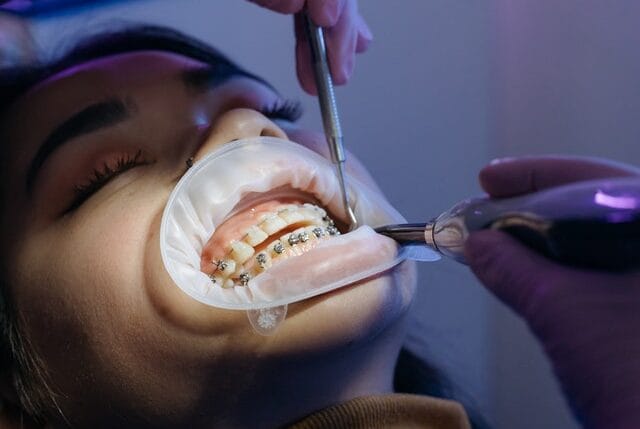Jaw pain happens sometimes, especially after a very chewy lunch. However, if your jaw hurts all the time, you may have a bigger problem. And if you ignore your jaw pain, you face grave consequences.
It’s time to discover the signs and symptoms of temporomandibular disorders (TMD), and find out how you can correct these issues before they cause you more than just pain.
What Are TMD and TMJ?
Your temporomandibular joint (TMJ) connects your jaw to your skull. This joint along with the surrounding muscle allows you to move your jaw up, down, forward, backward, and side to side.
This movement makes it possible to talk, eat, and smile.
Temporomandibular disorders (TMD) is a term used to describe problems with your TMJ and surrounding muscles. And it’s a common condition. In fact, over 10 million Americans suffer from TMD.
Symptoms of TMD
- Jaw pain
- Headaches
- Tenderness in the face
- Jaw locking
- Inability to open mouth wide
- Difficulty chewing
- Facial swelling
You may also have toothaches, neck aches, dizziness, earaches, pain behind your eyes, and hearing problems.
What Causes TMD
There are various ways you can strain your TMJ:
- Teeth grinding (bruxism): Grinding your teeth from habit, stress, or even subconsciously can hurt more than just your teeth or enamel. It can place significant pressure on your jaw that can lead to TMD.
- Injury: Getting hit in the jaw or whiplash can also cause jaw pain.
- Misaligned teeth: Straight teeth aren’t just a good aesthetic. An incorrect bite can lead to the long term deterioration of your TMJ. Each unhealthy bite causes your joint to rub against your skull, causing chipping and/or inflammation.
The Consequences of Untreated TMD
If you don’t find treatment for TMD, your jaw pain will be the least of your worries. Long-term TMD can significantly lower your quality of life.
Everyday tasks, such as eating, talking, and brushing your teeth will become very challenging due to the pain and swelling.
It can also lower your sleep quality. With a misaligned jaw, less oxygen enters your brain when you’re asleep. As a result, you can develop an airway sleep disorder.
Combine that with hearing problems and recurrent headaches, and you’ll see why you need to seek treatment for TMD as soon as you notice symptoms.

5 Ways to Treat TMD and Stop Your Jaw Pain
After reaching a diagnosis, your TMD treatment plan will depend on what caused the problems in the first place. In the meantime, you can try home remedies to manage your symptoms.
1. Home Remedies
Over-the-counter pain medication, such as ibuprofen, can help manage pain and soothe inflammation.
If your face is swollen, try applying a moist heat- or cold compress. 10 minutes of this and some gentle jaw exercises can reduce your swelling.
Try eating soft foods when your jaw is especially painful. Opt for soup, mashed potatoes, oatmeal, and even applesauce instead of anything that requires a lot of chewing
It’s important to avoid extreme jaw movements. This will make your TMJ more sensitive. Also, avoid resting your jaw on your hand or holding your phone between your shoulders and ears.
2. Invisalign or Braces
If your TMD is a result of a bad bite, you need a dentist or orthodontist to find appropriate treatment. Usually, a bad bite happens when your teeth are misaligned.
Braces or invisible aligners (Invisalign) can correct this effectively.
3. Nightguard
If your jaw hurts due to teeth grinding or clenching, you need to consciously break that bad habit.
Sometimes, people grind their teeth out of stress or frustration. Healthy stress management can even improve your TMD. Yoga, meditation, and exercise can all be very relaxing.
However, sometimes the grinding isn’t a conscious or noticeable action. On average, 10% of people grind their teeth at night regularly. While you can’t exactly stop yourself from doing it, a night guard can help your teeth and your TMJ stay healthy.
4. Botox
You may have heard of botox as a popular injection treatment for getting rid of wrinkles and signs of aging. However, there’s more to this neurotoxin protein than you think.
In certain experimental treatments, botox helped alleviate the symptoms of TMD. With botox, the pain from TMD lowers semi-permanently. You can even enjoy wider mouth movement for up to three months after the injection.
5. Surgery
In rare and severe cases, surgery may be the most effective option to treat TMD. There are three kinds of surgeries that can help depending on the situation:
- Arthrocentesis: If your jaw is locked, a simple surgical procedure can dislodge the joint. This procedure is usually done by a dentist under general anesthesia.
- Arthroscopy: Under general anesthesia, your doctor will make a small incision below your ear and use a tiny camera to see inside your joint. (This is a minimally invasive procedure. But, the surgery does leave a small scar.)
- Open joint surgery: If you have bone damage, tumors, or chipping around your joint, arthroscopy may not be possible. Instead, the doctor needs to open up the whole area around your joint to examine and treat your condition. (Scarring and nerve damage are a greater risk at open joint surgery.)
Get Treatment for TMD in New York City
If your jaw hurts a lot, you may be suffering from a form of TMD. And the first person you need to see about it is the dentist.
If you live in New York City, Advanced Dental Arts can help you investigate what the cause of your jaw pain is.
We’ll examine your jaw joints, assess your bite, and discuss any potential teeth grinding. Afterward, we’ll help you find a suitable treatment to alleviate your symptoms and restore your jaw health. Whether you need Invisalign, a nightguard, or a more invasive procedure, we can help you find relief from TMD.
Book an appointment today at Advanced Dental Arts to find out why your jaw hurts today!





